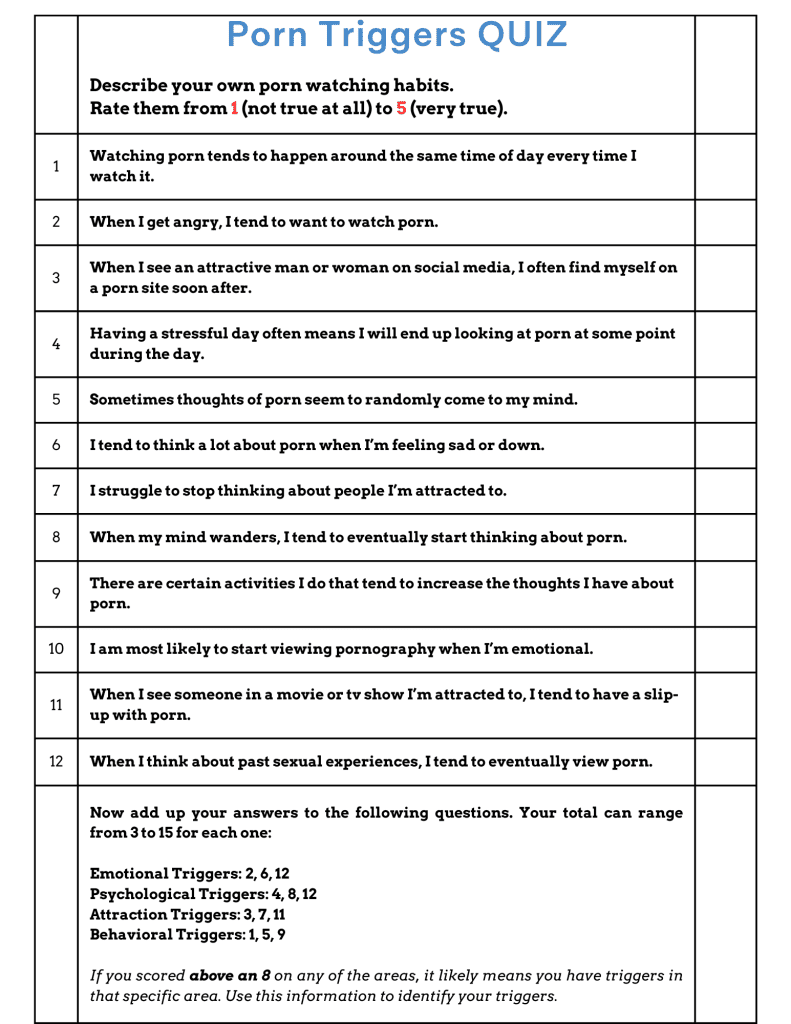One of the most important things to understand about pornography habits and addictions is that watching porn often doesn’t feel like a conscious choice. If you’ve struggled with porn, you know what we’re talking about.
You likely have wanted to stop watching porn, maybe for a long time. Yet time and time again, you find yourself coming back, often immediately regretting your decision but only after the fact. It feels like you’ve lost your ability to choose – something that can be incredibly frustrating.
These feelings result from compulsions that develop when we link our brain to watching porn (see this resource for more information on this topic). This compulsion is what makes porn so difficult to quit. We designed this resource to help you overcome a bad porn habit or addiction by targeting the most important part of a compulsion – discovering what sets it in motion in the first place. Therapists call this a trigger.
A trigger is something that happens to you that “triggers” a line of thinking and/or behavior. Think about a trigger like the first domino in a long stack of dominoes, all lined up together. Push the first one over and the rest will fall, one by one.
A trigger can be a thought, action, or something that happens in your environment. With pornography, a trigger is something that happens that first puts the thought of porn into our mind. That first thought then triggers the growing desire for watching porn. Eventually a trigger leads to you pull up a pornography video or picture.
Triggers are important because if that first domino doesn’t fall, the rest of the dominoes will stay in place. When it comes to trying to break out of a porn habit or addiction, stopping the first domino can mean eliminating the chain of events that leads to slip-ups or escalating porn viewing.
We want to help you, firstly, to understand your porn triggers.
Next we will help you find ways to prevent triggers from turning you to porn. Let’s start with the different types of porn triggers to help you better identify what some of your triggers might be.
There are four common porn triggers. We’ll help you understand what each one is, and then give you some tips on overcoming that specific type of trigger. After that, we’ll give you a little quiz you can take to help you evaluate what triggers might be the most likely to occur in your life.
As you read through these triggers, keep a few things in mind. First, this list is not exhaustive. Almost anything can be a trigger, so it’s not safe to assume that these four areas will cover anything that might trigger you to view porn. These are simply the most common areas. For this reason, consider other things in your life that may not be on this list as potential porn triggers.
Secondly, most people who struggle with porn have multiple triggers. Don’t assume that your triggers will only fall into one category. Typically you may have triggers in multiple categories, if not all four. Remember, the more you understand about why thoughts of pornography come to you, the better you will be able to overcome these urges.

Identifying and overcoming emotional triggers
Emotional triggers may be the most common type of trigger out there when it comes to porn. Emotional triggers happen when we feel strong emotions that lead to thoughts about porn.
The two most common emotional triggers for porn are anger and sadness.
For many people who struggle with porn, the first thought of viewing porn can be triggered by strong feelings of frustration and anger, or feelings of being gloomy or down.
Emotional triggers connected to sadness are often the most common type of emotional trigger out there. No one wants to feel sad, lonely, or depressed. We naturally want to find things that can distract us from feelings of sadness.
While there are a variety of things we could turn to (like exercise, friends, or even a good book), for some these feelings of sadness trigger thoughts of porn.

Because the brain has associated porn viewing with pleasurable experiences tied to masturbation, it assumes that porn is a way to escape the feelings of sadness being experienced. While the pleasure tied to porn is short-lived and comes with a host of other problems, the brain’s association with porn and pleasure is why emotional triggers tied to sadness are so common.
Emotional triggers can sometimes be tied to our existing romantic relationships. We may be frustrated with something our partner did, said, or didn’t do. One very common example of this is a pornography user with an emotional trigger tied to frustrations around intimacy in their relationship.

Perhaps their romantic partner is not engaging in intimacy at the frequency they desire, or refuses to engage in intimate behaviors they hope to enjoy. Instead of communicating this in a healthy way, unspoken relational frustrations can then lead to thoughts about porn.
Anger-based emotional triggers do not need to be tied to the relationship though. Frustration with work, school, extended family members, or just about anything can also serve as an emotional trigger.
Overcoming emotional porn triggers

1. Identify the source of negative emotions.
The key to overcoming emotional triggers comes in two stages. Stage one involves identifying the source of these emotions and working on improving those areas of your life.
If you find yourself consistently angry or sad, what part of your life is creating these emotions?
- Is it work?
- Your relationships?
- Your friends?
Once you find the source, get even more specific.
What exactly happens that makes you feel this emotion? Once you can isolate the common sources of these emotions, put extra energy into improving this area of your life.
If work is causing you a lot of anger, figure out what you can do to improve your work situation. Consider talking to your boss or maybe even consider looking for a new job that will provide a better emotional climate for you.
As you work on dealing with the source of these emotions, you will find that the negative emotions you experience will appear less frequently. The less these emotions are experienced, fewer porn triggers will arise.
2. Create alternate coping mechanisms.
The second stage is also important. It is impossible to simply eliminate everything in your life that creates negative emotions.
No matter how hard you try, you will still feel anger or sadness at some point in your life. Instead, finding alternative coping mechanisms targeted specifically at each negative emotion is helpful.
Take anger for example. If anger is a trigger for you, you need to find and practice alternative ways to cope with your anger.
Perhaps you could start taking a walk or jog each time you feel angry.
Perhaps you can give yourself 10 minutes of play time with your favorite pet the next time you feel frustrated.
The activity doesn’t matter, as long as it’s not porn!
Start to retrain your brain, so that when you feel a certain emotion, you always do something different.
The more you do this, the less likely this emotion will be to trigger thoughts of porn in the future.
Key takeaways for overcoming emotional triggers:
1. Identify the source of your negative emotions in the moment or leading up to the moment.
2. Create alternate healthy coping strategies for dealing with these emotions.
Why it works? You are retraining your brain patterns.
Identifying and overcoming psychological porn triggers
A psychological trigger is a trigger focused on a thought or mental state that then generates the urge to watch porn. Probably the most common psychological trigger is stress or anxiety.
While stress and anxiety feels slightly different for every person, one common trait of stress is that we start to think, if not obsess, about the things we’re stressed about.
Stressed at work? You’ll likely find your mind fixated on all the things you need to get done by the next day.
Stressed about a child and parenting? You’ll probably spend a lot of time thinking about that child and the specific areas you’re worried about.
We don’t like feeling stressed, and so our brains naturally want to distract ourselves from these stressful thoughts.
Often we do this by replacing the stressful thinking with thoughts the brain believes are more pleasurable. That’s where porn can come in. Your brain may try to replace the stressful thoughts with the thought of viewing porn, starting the chain of thinking that can lead to actually watching porn.
Stress is not the only psychological porn trigger out there. There may be other thoughts you have that naturally trigger thoughts of porn.
Perhaps you notice that every time you think about previous girlfriends or boyfriends, the thoughts of porn soon follow.
Maybe once you think about a certain person you have a crush on, thoughts of porn soon follow. Note that this is slightly different from the attraction triggers we will talk about soon (those triggers are not about thinking about a person but the feeling of attraction we feel toward them).
The key to understanding psychological porn triggers is that they are always a chain of thoughts.
One thought or topic of thought, unrelated to porn, will trigger the first thought of porn itself.
How to overcome psychological triggers
1. Identify recurring thought patterns.
Like many triggers, the key to overcoming psychological porn triggers is first to identify the most common thoughts you have that trigger thoughts of porn.
Think about this like a knot of thoughts that’s tied up in your head. You need to spend some time thinking about the last few times you watch porn, and then unravel this knot.
What were your thoughts about immediately before you picked up your phone or opened your computer?
What thoughts came before that?
Keep working your way backwards until you find the point where the previous thought was not about porn, but about something else.
This will help you figure out what your psychological triggers might be. They may be about work, home life, or just about anything.
2. Journal about these discoveries.
If you continue to slip up over time, use these notes to look for patterns in your thinking.

3. Practice redirecting psychological porn triggers.
Once you have identified the common psychological triggers for you, the next step is to practice a technique called redirecting.
This means that once you have a thought tied to a trigger, you want to teach your brain to redirect to something unrelated to porn or the original topic.
The first step is to pick one or two topics you like to think about. This could be movies, books, a sports team you enjoy, or just about anything.
Once you choose your redirect topics, the next time the trigger topic comes into your head, immediately start thinking about your redirect topic for at least five minutes.
For example, let’s say your redirect topic is sports and your trigger is stressful thoughts about work. The next time you find yourself at home stressing about an upcoming work project, immediately jump onto a sports website and spend the next five minutes thinking and immersing yourself into that topic.
Eventually, this will help your brain stop associating porn with the psychological triggering thoughts that have prompted porn use in the past.
Key takeaways for overcoming psychological porn triggers:
1. Identify recurring thought patterns.
2. Journal about these discoveries.
3. Practice redirecting when triggered. Teach your brain to think about a different topic unrelated to porn for at least 5 minutes.

Identifying and overcoming attraction triggers
Attraction triggers happen when we see a stimulus that prompts us to feel sexual attraction toward someone.
This is different than just thinking about someone we like.
It’s the actual physical response we have when we desire intimacy with another person. Our heart may skip a beat, we may notice a genital response, or we may have a quick thought about kissing or holding their hand. Attraction is a normal and healthy part of the human experience.
We will often feel attraction toward those around us as we go about our day to day lives. Marketers also know the power of attraction and will often attempt to elicit these feelings in advertisements by using attractive people as models.
Social media is a newer platform that can trigger feelings of attraction toward others as we scroll through our feeds on various social media platforms.
Regardless of the origin, when we have feelings of attraction toward another person, we often don’t do anything with those feelings. Perhaps, if single, we may seek out a conversation with someone we find attractive, but for the most part, we simply let these feelings pass.
For someone with a pornography habit or addiction, feelings of attraction can develop into triggers that lead one down the road toward pornography. This is because these same feelings of attraction are often felt while viewing porn.
When viewing porn, we are often sexually attracted to the people we are watching in pornographic material. Because of this, feelings of attraction can eventually trigger memories of the same feelings that were felt while viewing pornography.
In this way, feeling attracted to someone (real or fictional), can trigger thoughts of pornography.
How to overcome attraction triggers
The first and most basic step to take to overcome attraction triggers is to reduce or eliminate situations where this attraction is triggered.
1. Inspect and honestly evaluate your media use: social media, magazines, movies, music. (Get rid of your stash.)
Perhaps the most obvious area of life where this can be the case is in media use. If you watch certain shows or movies triggering feelings of sexual attraction that may result in thoughts about porn, consider limiting how much of this media you consume.
Or you can seek out filtered versions of TV and movies!
If certain song lyrics make you think about sex, stop listening to that music. In today’s world, social media provides the most accessible and constant bombardment of sexual images.
If social media is often where you find attraction triggers beginning, it may be time to reduce or eliminate your social media use.
Of course, avoiding attraction triggers in our day-to-day life with real people can be more challenging to avoid.
2. Practice redirecting, the same technique mentioned above in relation to psychological triggers.
Redirecting means preparing certain topics ahead of time to think about when potentially triggering thoughts or feelings come to mind.
In this case, if you feel attraction to someone in your daily life, immediately (or as soon as possible), spend five minutes redirecting your thoughts to something else.
3. Use accountability software and set up strict filters.
Setting up accountability software on all of your online devices provides a boundary online that helps you redirect. Accountability means you are willing to share your online activity with another trusted person. 95% of accountability app users see a drastic reduction in porn use, because knowing someone else will see where you visit online is a powerful deterrent!
The rewards are two-fold. First, this helps train your brain that feeling sexual attraction does not need to lead to viewing porn. Next, this practice provides a cognitive reminder of your decision to eliminate porn from your life. It will help you remember the reasons why you are trying to redirect your thoughts – a process that can give you the courage and strength to move forward without pornography.
Key takeaways for overcoming attraction triggers:
1. Inspect and honestly evaluate your media use: social media, magazines, movies, music. (Get rid of your stash.)
2. Practice redirecting, the same technique mentioned above in relation to psychological triggers.
3. Use accountability software and set up strict filters.
Identifying behavioral triggers
Behavioral triggers occur when a specific behavior is done that is unassociated with porn or even sexual intimacy, but still triggers thoughts of porn. The best way to understand behavioral triggers is to think about basic mental associations. Sometimes, our brains associate two things that aren’t related together, simply because they have been paired together in our lived experiences in the past.
For example, perhaps you had a bad bout of food poisoning right after you visited a local restaurant. Even if you aren’t sure their food was the reason for your sickness, every time you think about the food from that restaurant, you get nauseous. This is a mental association your brain has made between that food and an unpleasant experience.
Essentially, when we experience a strong positive or negative experience in life, our brain tries to attach those rewards to something. If something happens the brain thinks is negative, it will try to create a negative mental or physical experience through association to help you avoid future negative experiences. If something happens that the brain thinks is rewarding, the brain wants to associate that reward with something so it can experience the reward again.
Behavioral triggers connected with pornography happen when porn viewing gets tied to daily habits in our life.
As a common example, let’s say that someone typically views porn at night in bed, after scrolling through various apps on their phone for 15-30 minutes. Eventually, just the act of getting into bed with a phone could become a behavioral trigger that makes this person start to think about porn.
As another example, let’s say that a husband tends to slip up with porn every time his wife takes a trip for work. Over time, simply seeing his wife pack a suitcase may start to trigger thoughts about porn. As you can see, behavioral triggers can be tied to just about any behavior. They rarely have any connection to porn, sex, or even relationships.
Behavioral porn triggers are simply the brain tying what it thinks are the rewards of porn to repeated behaviors around the time the porn watching occurs.
How to overcome behavioral porn triggers
Behavioral triggers are often some of the hardest to overcome, because the thoughts that these behaviors trigger are often buried deep in our subconscious. Since these have no obvious connection with pornography, such behaviors are sometimes harder to pinpoint.
1. Identify linked thoughts and behaviors.
For that reason, the first step is to identify them. We recommend you always carry a small personal journal with you. Pay attention to when a thought of porn or watching porn comes to mind. Immediately note your surroundings and what you have just been doing. Over time, see if you can identify patterns that may offer clues as to what behavioral triggers exist in your life.
14-Day Free Trial
Protection From Pornography
Change your habits, change your life: Start our 14-day free trial to help get rid of pornography for good.
2. Change up your routine.
Then, you can take the simple step of changing up your routine. In most cases, behavioral triggers are very specific. If having a phone in bed is a behavioral trigger, leave your phone in the living room when you go to bed. Simply changing up small details of the behavioral triggers is sometimes enough to stop triggering thoughts of porn.
3. Take time for reflective writing.
Another thing you can do is to engage in some reflective writing about past experiences with pornography. Sit down and write down the last several situations where you eventually viewed porn. Pay particular attention to what you were doing and where you were then this occurred. What was happening earlier in the day when the thoughts started?
Ideally, if you can write about a dozen or so of these experiences, you will be able to start to identify more behavioral patterns that may offer clues to your triggers.
Now the goal is to simply be intentional about changing up these behavior routines. Do something different in these scenarios to disconnect the associations your brain has made between that activity and porn.
4. Take the porn triggers quiz for helpful evaluation.
The following short quiz will give you additional insights into the types of triggers that may be the most common in your life.
Key takeaways for overcoming behavioral porn triggers:
1. Identify linked thoughts and behaviors and write them down. (Carry a small journal with you.)
2. Change up your routine. (Ex: no phone in the bedroom)
3. Take time for reflective writing.
4. Self-evaluate your porn triggers with our quiz.
Porn Triggers Quiz
Instructions: Answer the following questions as honestly as you can. For each one, think about how true each statement is in terms of describing your own porn watching habits from 1 (not true at all) to 5 (very true).
Now add up your answers to the following questions. Your total can range from 3 to 15 for each one:
Emotional Triggers: 2, 6, 12
Psychological Triggers: 4, 8, 12
Attraction Triggers: 3, 7, 11
Behavioral Triggers: 1, 5, 9
If you scored above an 8 on any of the areas, it likely means you have triggers in that specific area. Use this information to identify your triggers.

14-Day Free Trial
Protection From Pornography
Change your habits, change your life: Start our 14-day free trial to help get rid of pornography for good.



